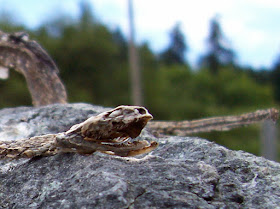 |
| The restored Kinsol Trestle is now open for crossings |
Recent History of Kinsol Trestle
Before the decision was made to save this piece of west coast timber history, the wood trestle was slated for demolition. The last train crossed the trestle in 1979, the line was abandoned, and eventually the structure was near collapse. The Kinsol Trestle, the oldest free-standing timber structure in North America, had been left to deteriorate in the wet forested valley of the Koksilah River.
The amount of heavy timbers required to support a fully loaded logging train is huge. It was expected that the proceeds of the good timber left in the structure would be significant. 80% of the 1.2 million board feet of timbers were found to be sound after core samples were taken in 2007.
 |
| The deteriorated bridge deck before restoration |
The giant trees felled for the original structure have long disappeared from the area. Replacements for the large, incredibly strong Douglas-fir timbers came from forests in the Alberni Valley.
The 7.5 million dollar project brought the 101 year old trestle back to its original world-class form. The international restoration firm Macdonald and Lawrence Timber Framing Ltd., the same outfit that restored the heavy timbers of England's Windsor Castle after a fire, did the work on the trestle. They are "a specialist carpentry company offering a range of services to assist private and professional clients build and conserve timber structures."
 |
| Beginning of project one year ago |
Hauling Lumber Over The Trestle
"The Kinsol is special as it features a 7 degree curve over a low level Howe truss. Immense, at 145 ft tall and over 600ft in length it is engineering at its finest.
From 1920 to 1979 it is said that 5 billion board feet of timber was brought to market from Lake Cowichan's vast reserves over the CNR trestle.
Railway lore has steam engineers getting out and walking over the trestle and waiting for the brakeman to set the trains into motion, as the bridge at times would sway under the great loads of steam engines and their cargo of massive timber atop the rail cars.The engineers would then step aboard and slow the train for the brakeman, who would follow across on foot and join up with the crew!" - source
 |
| Photo of trestle from 1950 when trains were still running |
Early Kinsol Trestle Timeline
1910 -- Mackenzie and Mann, promoters of the Canadian Northern Pacific Railway, contracted to build Vancouver Island line from Sidney through Victoria to Barkley Sound.
1911 -- Sod-turning ceremony staged in February.
1914 -- By this time some 700,000 feet of timber had been cut and stacked on both sides of the Koksilah River at Mile 51.9, site of the Kinsol Trestle (named for a nearby copper mine, the King Solomon).
1918 -- Only four miles of track had been laid from Victoria, and some timber work completed on the trestle, by 1918 when the federal government resumed construction as part of the new Canadian National Railways.
1919 -- Sept. 18, 1919, the Cowichan Leader reported: "At long last a real start has been made on the Koksilah River (crossing)." 55 men (local farmers and loggers) were employed on the project.
1920 -- By April the canyon had been bridged. Built on massive concrete piers, the Kinsol Trestle was 145 feet high and 614 feet long.
1924 -- Track reached Lake Cowichan. Weekly passenger service by gas car and the transporting of lumber products was begun. - source
Trestle Now Part Of Trans Canada Trail
The old rail line is now part of the 22,000 km Trans Canada Trail. The Kinsol Trestle is the largest of eight original bridges in the section of railroad through the Cowichan Valley. Some have compared it to southern interior BC's Kettle Valley Rail Trail before catastrophic fires destroyed some of its historic wood bridges.
The Kinsol Trestle is evidence of Vancouver Island ingenuity and determination during a time when no project was too large or too difficult. More though, it is evidence of the strength and utility of the strongest wood in the coastal forest - old growth Douglas-fir. Kilo for kilo it is stronger than steel.
 |
| This is an old map, but the directions are still accurate - click to enlage |
This giant wood trestle is an engineering marvel, and a bit of a conundrum - a huge bridge built out of massive old growth Douglas-firs so that rail cars could pass over as they hauled more massive trees to market.
The Kinsol Trestle is an interesting part of our history that eventually lead to the liquidation of 90% of south Vancouver Island's old growth forests. This is one world class timber structure not to be missed, and is about all we have to show for our efforts to subdue the deep, dark, primeval forest. Big logs passed this way.

















